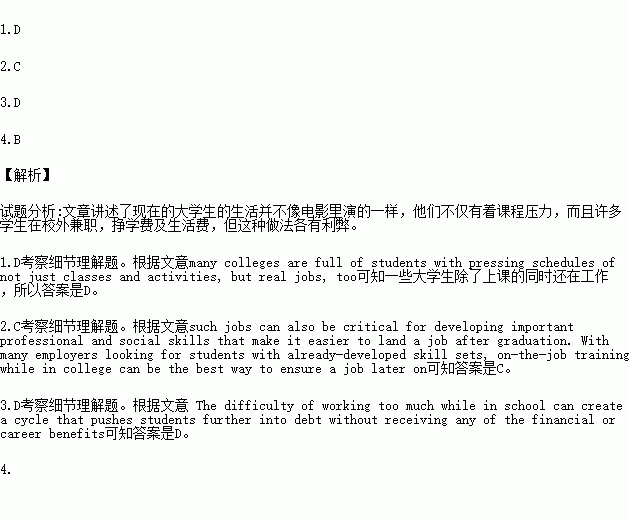题目内容
In colleges around the country, most students are also workers.
The reality of college can be pretty different from the images presented in movies and television. Instead of the students who wake up late, party all the time, and study only before exams, many colleges are full of students with pressing schedules of not just classes and activities, but real jobs, too.
This isn’t a temporary phenomenon.The share of working students has been on the rise since the 1970s, and one-fifth of students work yearround. About one-quarter of those who work while attending school have both a full-courseload and a full-time job. The arrangement can help pay for tuition (学费) and living costs, obviously. And there’s value in it beyond the direct cause: such jobs can also be critical for developing important professional and social skills that make it easier to land a job after graduation. With many employers looking for students with already-developed skill sets, on-the-job training while in college can be the best way to ensure a job later on.
But it’s not all upside. Even full-time work may not completely cover the cost of tuition and living expenses. The study notes that if a student worked a full-time job at the federal minimum wage, they would earn just over $15,000 each year, certainly not enough to pay for tuition, room, and board at many colleges without some serious financial aid. That means that though they’re sacrificing time away from the classroom, many working students will still graduate with at least some debt. And working fulltime can reduce the chance that students will graduate at all, by cutting into the time available for studying and attending classes.
There is little reward for attending but not finishing college. Students who wind up leaving school because of difficulty in managing work and class are likely to find themselves stuck in some of the same jobs they might have gotten if they hadn’t gone at all. The difficulty of working too much while in school can create a cycle that pushes students further into debt without receiving any of the financial or career benefits.
1.According to the passage, the reality of college students is that ______.
A. they throw parties a lot
B. they stay up late every night
C. they pay no attention to exams
D. they work besides attending classes
2.What is the indirect cause of an increasing number of working students?
A.The need of developing social networks.
B.The lack of summer jobs for young adults.
C.The chance of finding a job after graduation.
D.The expenses of high tuition and living costs.
3.We can learn from the passage that ______.
A. working students are more likely to finish college
B. students can cover their college expenses through working
C. students receive a huge reward for managing work and class
D. dropping out of college may not help students get career benefits
4.What is the best title for the passage?
A. The Difficulties of Landing a Job
B. The Struggle of Work-School Balance
C. The Reward of Working While Studying
D. The Images of Working College Students
 应用题作业本系列答案
应用题作业本系列答案

 ),并在其下面写出该加的词。
),并在其下面写出该加的词。